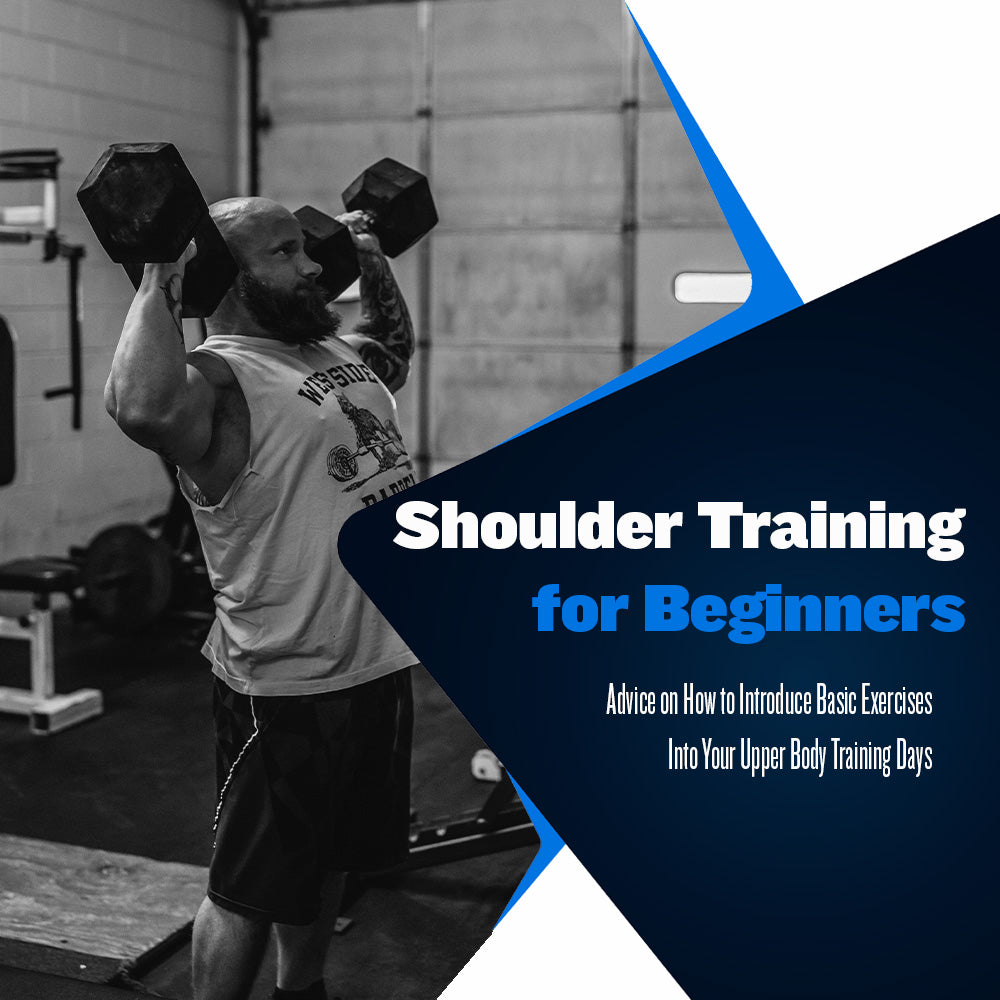Shoulder Training for Beginners

When you begin weight training, it is important to have a sensible approach that ensures proper training of the muscle groups responsible for supporting the large joints of the body. By adequately training these muscle groups, you raise your strength training preparedness while simultaneously decreasing your risk of injury.
Today, there is an unfortunate trend of popularizing the belief that exercise risk reduction is achieved solely by limiting the loading of the barbell and focusing on the movement skills necessary to accomplish a lift.
While it is undoubtedly vital to focus on developing movement skills that allow you to best use your physical structure, it is just as important to increase an athlete's preparedness through the use of intelligent volume and intensity regulation. A significant group of muscles that beginners should immediately focus on is the muscles that support the shoulder joints.
The shoulder is made up of four joints; the glenohumeral joint, the acromioclavicular joint, the sternoclavicular joint, and the scapulothoracic joint. These joints are supported by various upper body anterior and posterior muscle groups.
Because of the ball and socket design of the glenohumeral joint, the shoulders become unstable and prone to injury when not properly trained and strengthened. If you want to bench press heavy weights while also having the shoulder mass and durability necessary to support heavy squat bars and heavy deadlifts, you need to train your shoulders.
Here are a few exercises we suggest to begin building strong shoulders:
Overhead Kettlebell Press
The overhead kettlebell press is an excellent choice for beginners considering how it places a demand on the hand, wrist, and shoulder. This exercise is low risk and puts the hand and wrist in an advantageous position to ensure no unnecessary burden is placed upon the shoulders due to the wrists struggling to control a dumbbell.
To perform this movement, you will hold kettlebells by the handles, allowing the rest of the kettlebell to lay flush with the forearm. Once you have the handle in hand and the weight on the backside of the forearm, you will press the kettlebells overhead as you would with a barbell or dumbbells. This exercise can be performed standing or seated.
As far as programming this exercise goes, we recommend three to five sets of ten to fifteen reps as an upper-body accessory exercise.
This exercise allows inexperienced lifters the benefits of overhead or seated dumbbell presses without worrying about any adverse effects on the wrists or loss of control due to weakness associated with overhead dumbbell presses.
Overhead Press
The overhead press is the exercise that all other shoulder exercises aim to build. Like the squat, bench, and deadlift, you must become accustomed to moving weights of differing intensities overhead.
Initially, beginners need to limit their weight, focusing instead on developing a movement pattern that is both safe and allows them to best use their musculoskeletal structure. However, this does not mean spending the next two years of training pressing a broomstick overhead.
Typically, it will take a beginner 1-3 months to become strong and skilled enough to feel comfortable pressing heavy triples or singles overhead.
Initial programming of this exercise would feature it as an accessory exercise on either upper body training day. You should perform three to five sets of eight to ten repetitions using a weight you can safely manage while still reaching adequate exertion levels.
Once skill progresses, you can begin featuring overhead press exercises as a max effort upper main exercise. This would include exercises such as push press, strict press, seated overhead press, Z press, or overhead press variations using specialty bars such as the axle or log.
When programmed as a max effort exercise, we recommend working up to top sets of three or all-out max effort singles. The choice would be influenced by the rep scheme and movement performed during the last max effort upper exercise and your plans for your next max effort upper training day.
Lateral Raises
Lateral raises are important to include during your beginning stages of shoulder training, considering the low risk compared to the benefit they provide the posterior muscles of the shoulder.
It is a simple exercise that solves a complex problem, building strength and stability to support the posterior shoulder joint. This is not only important in exercises such as the overhead press or bench press but also a great benefit when squatting or deadlifting.
Building up the posterior shoulders will improve the ability to maintain optimal thoracic posture during the squat and deadlift.
Lateral raises can be programmed as an accessory exercise during upper body training days. We recommend three to five sets of fifteen to twenty reps. This will ensure you get enough volume in while limiting the amount of weight you can use. You can begin reducing the rep count and increasing the weight as you progress.
Do Not Avoid, Attack
It has become an accepted thought that one should limit their shoulder training to reduce the risk of injury. However, this only leaves muscles responsible for supporting the most important joints of the upper body unprepared, and the tissue and joints at a greater risk of injury.
If you have to use a muscle group and joint, you need to prepare them adequately. This means the proper volume, intensity, and frequency levels to allow the tissue to develop and the joint to become accustomed to the new demands.
Passively focusing on shoulder training, or reducing the volume or intensity of the training, rendering it meaningless, will only lead to more of what you are trying to avoid - injury.
Find a weakness, attack a weakness. It should be the goal of anyone coaching or writing strength and conditioning programming. Strength leads to resilience; avoidance leads to failure and destruction.
Sources:
Simmons, L. (2007). Westside Barbell Book of Methods. Westside Barbell.
Verkhoshansky, Y., & Siff, M. C. (2009). Supertraining. Verkhoshansky.




